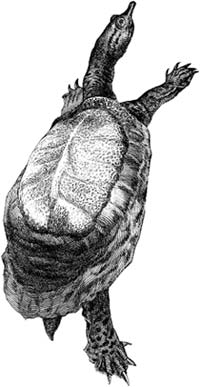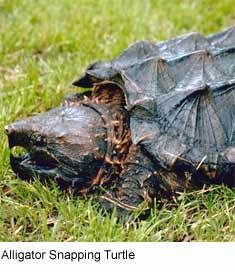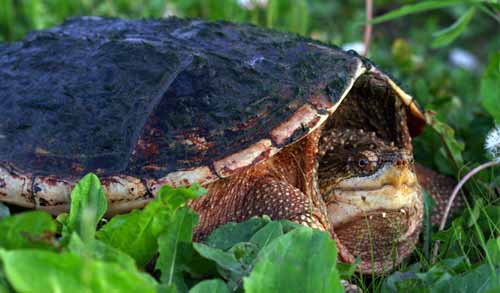|


Just the Facts: Snapping turtles are noted
for their powerful beak-like jaws
and pugnacious disposition. They have
a muscular build with ridged shells that may measure from 50 cm long in Chelydra species to some 80 cm long in the Alligator snapping turtle (Macroclemys temminckii).
Sizeable Snapper: The latter species is one of the largest freshwater turtles in the world, weighing up to 100 kilograms.
The Common Snapping turtle (C. serpentina serpentina) and its subspecies are much smaller, weighing up to 17 kilograms
in weight.
Snappers as Pets: Common snapping turtles kept as pets can become quite corpulent and difficult to move without their co-operation, and require frequent cleaning
of their water tanks to remain content and healthy. In some areas they are hunted heavily for their meat. They may live for 80 years or more.
Please Don't Touch: Snapping turtles have long spiked tails and necks which can reach two thirds the length of their shells, making handling dangerous. They cannot fully retract their head and appendages, relying on fierce displays when aggravated. Their snapping jaws and sharp claws are capable of inflicting serious injury; these turtles are best left alone.

Puppy Love: Strangely enough, the Common Snapping turtle, when raised in captivity from a hatchling, can sometimes become extremely docile and devoted to its owner. It may show signs of intelligence in recognizing individual people and will seek out those it prefers to be around. Some can be taught to obey simple commands with enough patience, but this can be a long process as Snapping turtles display the stubborn nature that is a defining characteristic of all turtle species.
Don't Walk, Swim:They are poorly suited to terrestrial locomotion, spending most of their time in ponds, shallow lakes and streams; Snapping turtles normally bask by floating on the surface with only their carapace exposed. Basking on land does occur at times. The belief that they never leave water to bask derives from the fact that they are very secretive about doing so. Other turtle species (Pseudemys, Chrysemys) are much more conspicuous in their basking habits.
They do come ashore: Rare forays onto land occur in June and July when females lay their spherical eggs. Male and female snapping turtles also travel overland to reach new habitat.
 Pollution, habitat destruction, food scarcity, over-crowding and other factors will drive snappers to travel across land. It is common to find Common Pollution, habitat destruction, food scarcity, over-crowding and other factors will drive snappers to travel across land. It is common to find Common
Snapping turtles traveling far from the nearest water source. Some may inhabit brackish environments, such as estuaries. All snapping turtles are omnivores and are important scavengers, but they also actively hunt fish, frogs, birds, and small mammals.
Amazing Tongue: The Alligator snapper has a flesh-red, worm-like tongue, which it uses to lure fish into its mouth.
Handling Turtles: it's a snap... It is a common misunderstanding that a snapping turtle may be picked up by its tail with no harm to the animal; in fact, this has a high chance of injuring the turtle. A handler also needs to be wary of injury to himself. Snapping turtles are aptly named, as they can snap with amazing speed and power, and a full-grown snapper can easily nip off a finger. The safest method, of course, is to avoid handling a snapper at all. Lifting a snapper with a shovel is a safe technique that protects both the handler and the turtle. Lifting the turtle just off the ground to move it is advised, as otherwise they can easily squirm and fall off the shovel.

All text is available under the terms
of the GNU Free Documentation License
|